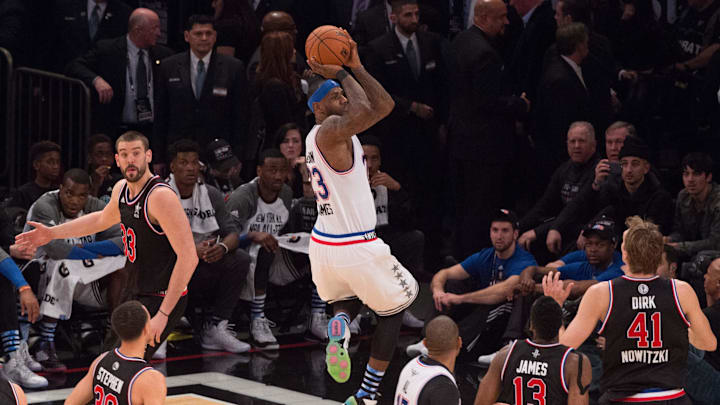The 2024 NBA All-Star game will see a change in format from its last six iterations with the “East vs West” returning for the first time since 2017. In the World of NBA All-Star game formats, change is constant and this is just the latest example of that.
The NBA All-Star Game was first introduced in 1951. The Main proponents of this concept at the time were then-NBA President Maurice Podoloff, NBA publicity director Haskell Cohen, and Boston Celtics owner Walter A. Brown. The game was hosted at the Boston Garden on March 2, 1951, only a few weeks after the sport of Basketball in America had been involved in a point-shaving scandal at the collegiate level.
The first NBA All-Star rosters
The game, which had both conferences represented with 11 players each, was successful at attracting plenty of spectators to the game and the league. The Eastern Conference All-Stars comfortably beat their West Counterparts 111-94 with Ed Mcauley taking Game MVP honors.
Since 1951, the game has been played every year (except 1999 due to the lockout) with progressive tweaks to the rules. When the first game was held in 1951, there were only 11 teams in the league and a rule was in place for each team to be represented in the game. With significant expansion to the league and only a one-spot increase in the All-Star team slots, this rule was discontinued in 1973.
NBA All-Star voting
For the first 24 All-Star games, the majority of the rosters (8 players per team) were selected by a panel of sportswriters and broadcasters with coaches deciding the rest of the roster. In 1975, a major change was made in the process with starters being selected through fan voting and the reserves being selected entirely by the coaches. This structure remained in place for over 40 years until the 2016-17 season when the players and media were added to the All-Star Starter voting (with 25 percent of weight going to each and the remaining 50 percent going to fans).
Between 1951 and 2012, there were designated “center” slots in the game. These were replaced by “Frontcourt” slots in 2013 as the position system was revamped in accordance with where the game was heading.
The NBA All-Star Draft
Since the inception of the game in 1951, perhaps the biggest change to the format was in 2018 when the conference-based teams were replaced by teams named after all-star captains in a draft format to almost replicate a pickup game of sorts. The captains were the two players with the most votes from the respective conferences. The captains then drafted the starters and reserves with alternating picks, with the live telecast of the draft from 2019 onward.
NBA All-Star games tries the Elam Ending
There was another significant change to the game in 2020, with a final target score instead of a conventional time-based ending. In a tribute to the late Kobe Bryant, the target score was 24 points more than the leading team’s score at the end of the third quarter. Along with this, the teams would win donation money for the charity of their choice if they won a quarter. 2020 produced one of the most thrilling and competitive games with a closing sequence to remember as Team Lebron beat Team Giannis 157-155. A similar format would remain until 2023. LeBron James would be a captain in all seven iterations of this All-Star game version, going unbeaten until Team Giannis finally defeated his team in 2023.
The NBA All-Star game brings back East vs. West
In 2024, we go back to the East vs West format. The Eastern Conference has the head-to-head on the West 37-29. However, the West did win six of the last seven games held between the conference teams.
The 2024 All-Star Game will mark LeBron James’ 20th All-Star game appearance, the most in NBA history, beating out Kareem Abdul Jabbar’s 19 selections. Along with the record for most selections, the 39-year-old already has set All-Star game career records for points and field goals. James will be joined by Luka Doncic, Shai-Gilgeous Alexander, Kevin Durant, and Nikola Jokic in a star-studded Western Conference starting lineup. The reserves for the team will be revealed on Feb. 1.
